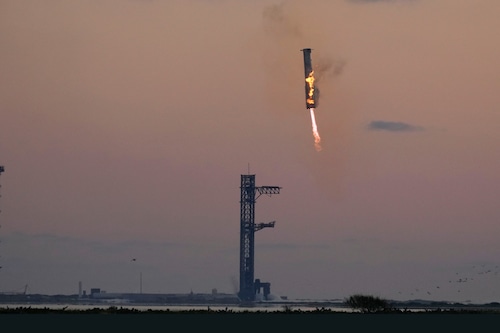On Sunday morning, SpaceX accomplished a remarkable engineering feat in space travel by launching the Starship spacecraft and successfully returning the Super Heavy booster to the launch site.
The 232-foot Super Heavy booster lifted off around 8:25 a.m. ET and returned shortly after, being caught mid-air by two large metal arms, which Elon Musk’s company calls “chopsticks.”
The company stated that the decision to return to the Texas launchpad was made mid-flight. SpaceX engineers were heard cheering on the livestream as the host celebrated the “absolutely insane” accomplishment, describing it as something that “looked like magic.”
Mechazilla has caught the Super Heavy booster! pic.twitter.com/6R5YatSVJX
— SpaceX (@SpaceX) October 13, 2024
“This is absolutely insane!” the engineer said as the booster was caught. “On the first ever attempt, we have successfully caught the Super Heavy booster back at the launch tower. What an incredible feeling.”
The return of the booster to Earth is a major milestone for the future of space travel. The ability to reuse rocket parts for multiple spaceship launches drastically changes the economics of the industry, putting Musk’s dream to “revolutionize humanity’s ability to access space” in sight.
“With each flight building on the learnings from the last, testing improvements in hardware and operations across every facet of Starship, we’re on the verge of demonstrating techniques fundamental to Starship’s fully and rapidly reusable design,” SpaceX said ahead of the successful test. “By continuing to push our hardware in a flight environment, and doing so as safely and frequently as possible, we’ll rapidly bring Starship online and revolutionize humanity’s ability to access space.”
SpaceX launched the Super Heavy booster for the first time last April, but it was not meant to return to the launchpad and exploded before it could.
Since then, significant improvements have been made to the rocket, including a rebuild of the Starship’s heat shield, designed to endure the intense temperatures during reentry into Earth’s atmosphere. While the spaceship glowed bright red as it traveled through space, the enhanced heat shield appeared to perform well.
The Starship is currently in a test flight expected to last around an hour, aiming for a landing in the Indian Ocean. Unlike the booster, the Starship is not yet designed to survive its landing.
Over three million viewers are watching the livestream.
Watch Starship's fifth flight test https://t.co/LVrCnTv797
— SpaceX (@SpaceX) October 12, 2024











